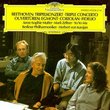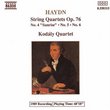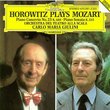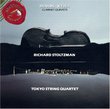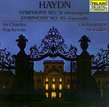| All Artists: Wolfgang Amadeus Mozart, Charles Mackerras, Prague Chamber Orchestra Title: Mozart: Symphonies Nos. 40 & 41 Members Wishing: 0 Total Copies: 0 Label: Telarc Release Date: 4/22/2003 Genre: Classical Styles: Historical Periods, Classical (c.1770-1830), Symphonies Number of Discs: 1 SwapaCD Credits: 1 UPC: 089408013928 |
Search - Wolfgang Amadeus Mozart, Charles Mackerras, Prague Chamber Orchestra :: Mozart: Symphonies Nos. 40 & 41
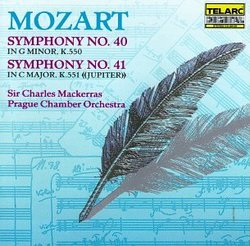 | Wolfgang Amadeus Mozart, Charles Mackerras, Prague Chamber Orchestra Mozart: Symphonies Nos. 40 & 41 Genre: Classical
Sir Charles Mackerras crowns a superb Mozart symphony cycle with these two marvelous performances, which marry 18th-century performance techniques to the warm tone of modern instruments. He also adds a discrete harpsichord... more » |
Larger Image |
CD DetailsSynopsis
Amazon.com Sir Charles Mackerras crowns a superb Mozart symphony cycle with these two marvelous performances, which marry 18th-century performance techniques to the warm tone of modern instruments. He also adds a discrete harpsichord accompaniment to the orchestra, such as might have existed in Mozart's time. With all the repeats taken and tempos swifter than the norm, Sir Charles Mackerras invests these symphonies with uncommon energy and stature. A fine disc which all Mozarteans should hear. --David Hurwitz Similarly Requested CDs
|
CD ReviewsMackerras Makes Magic! R. M. Rogers | United States | 12/29/2005 (5 out of 5 stars) "When a conductor undertakes the colossal task of recording the entire Mozart symphonic canon, it's pretty safe to assume that a great deal of research went into interpreting the music; and who better to perform the works of Mozart than an orchestra from Prague, the town that adored him. Add Telarc's marvelous digital sound quality into the performance and the result is a recording to die for. Mackerras' accounts of Mozart's final two symphonies are the most enjoyable, authentic, and technically flawless renderings of these masterpieces I have ever come across. The balance and tone of the Prague Chamber Orchestra is perfect and articulations during fast passages are extremely crisp and clear. The orchestra never sounds distant or muddled, and the music is always exciting. In the excellent liner notes, Mackerras explains his research into Mozart's original manuscripts in an effort to get as close as possible to performing the music as the composer intended. The orchestra observes all repeats (including the development/recapitulation of sonata form movements), and also adds a subtle basso continuo that is never intrusive. What stands out the most in Mackerras' interpretation is his choice of faster tempos, especially in the inner movements. The Andantes of both symphonies are often played as Adagios by other orchestras, and Mackerras correctly observes the Andante designation, which, after hearing so many other conductors plod through second movements, is a great relief and gives the movement new life and beauty. Likewise, the minuets are taken at a swift one beat per bar which Mackerras explains is more authentic. Again, this interpretation adds much energy to the dance movements. For those who are interested, Mackerras performs K550 with the original instrumentation of two oboes and no clarinets rather than the revised edition which included a pair of both. Likewise, only the first violin parts in the Andante of K551 are muted (most performances also mute the second violins). Mackerras made this decision after consulting Mozart's autographed manuscript and concluded that the composer intended to mute the first violins only. Mackerras admits in the liner notes that the change gave the movement more clarity. Finally, the wind parts, which are often dominated by the strings in other performances, are brought out quite nicely, making their statements when called for and then tastefully retreating back behind the string melodies. The horns in the trio of K550's minuet are especially lovely, as are the flute and double reed solos in the finale of K551. Having heard more performances of these works than I care to mention, I can say with conviction that these accounts are hands down the most perfect and sublime renderings available today. Add it to immediately to your collection, it's an absolute steal." Utterly Airbourne Mozart Grady Harp | Los Angeles, CA United States | 02/22/2006 (5 out of 5 stars) "With nearly three hundred recordings of Mozart's last two symphonies in the current catalogue alone (not to mention those that have been deleted or are in the process of being re-mastered) this final installment in the recordings by Sir Charles Mackerras of the entire symphony cycle proves something special. Mackerras conducts the Prague Chamber Orchestra in these transparent works that make them seem like wind through harp strings. Some may prefer the more somber, thicker sound of orchestral palette opted for by other master conductors, feeling that the darker sound gives more emotional weight to these final symphonies. But even without the benefit of having heard Mackerras' complete cycle the distinction of this CD is unmistakable. He never forces the fortes, never lets the slow movements become morose, and never uses tempi so fleet that the articulation of the strings is lost. Listen carefully and the subtle use of the harpsichord is present. Mackerras favors the Mozart size chamber orchestra and brisk tempi but polishes these aspects by immaculate playing by his orchestra members who use modern as opposed to period instruments. The result is, well, Mozartean, and rarely have these works felt so completely right. Making a list of recommended recordings of all of Mozart's works in this his birthday year would definitely place this CD high on the list. It is as though the symphonies are entirely new. Highly recommended. Grady Harp, February 06" Cheesy cover doesn't mean it K. Kitto | Oak Park, IL USA | 07/03/2006 (5 out of 5 stars) "This is a passionate and vivid recording of some terrific and moving Mozart."
|

 Track Listings (8) - Disc #1
Track Listings (8) - Disc #1